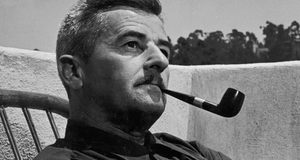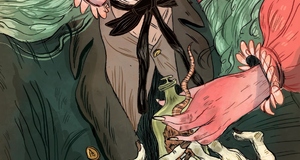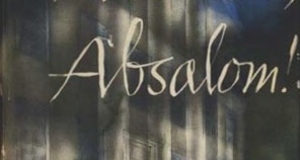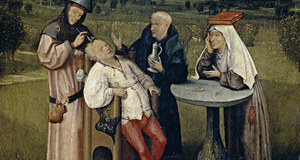Divinity in the Disguise of Mental Illness in William Faulkner's The Sound and the Fury
By
2017, Vol. 9 No. 05 | pg. 1/1 The character of Benjy Compson from William Faulkner’s 1929 novel The Sound and the Fury is a mythic and Christ-like figure with the divine gift of prophecy rather than the retarded man-child that the other characters in the novel view him to be. To see the world through Benjy’s eyes, you must be part of a very exclusive club with a two prong membership: that of autism and that of synesthesia. Autism is a developmental disorder most often characterized by impairments in forming normal social relationships and impairments in being able to communicate with others. Synesthesia itself is also a disorder, caused by a neuropsychological trait where the stimulation of one sense causes the automatic experience of another. For example: being able to taste numbers or feel colors. Faulkner uses Benjy Compson, a character who lives outside man-made constructs such as time, race, and morality in order to show that these constructs are just that: man-made theories that have no impact on the natural occurrences of the world and its day to day movements. By labeling Benjy as someone who struggles with mental illnesses such as autism and synesthesia as an “idiot” we are defining him using our own man-made standards. But Benjy’s so-called illnesses are actually divine gifts that let him perceive the world through an enlightened eye. Benjy’s narrative evinces how someone with autism experiences the world, most specifically through sound. In the following passage, he displays two signs of autistic behavior: “but I didn’t stop and mother caught me in her arms and began to cry and I cried. Then the cushion came back/She led me to the fire and I looked at the bright, smooth shapes. I could hear the fire and the roof. Father took me up. He smelled like rain” (64). The first is that when faced with loud noises, such as his mother crying, his immediate response is to become upset. The second is the effect that the sensory has upon him. Besides his sister Caddy, the sensory is the only thing that soothes him. Today, when autistics get upset, the people who care for them know to give them their “security blanket:” a sensory object special to them that has the ability to calm them down. But the most telling symptom of autism that Benjy displays is the sounds that he makes. He moans, he bellows, and he cries when he is upset or needs or wants something; all signs of a non-verbal autistic trying to communicate with the world. In addition to displaying autistic symptoms, Benjy exhibits symptoms of synesthesia. His whole life experience is based on smells, shapes, and sounds. In her graduate thesis “An Indescribable Sound in William Faulkner’s The Sound and The Fury” Lynn Ramsey writes that “Benjy’s narrative voice evinces a synesthetic relationship with his world, in which Faulkner crafts him as a sort of metaphysical poet who views the world through the curling flower spaces. He orders his bright world through his senses” (Ramsey 6). Lynn perceives him as a metaphysical poet due to the very differences that cause him to be labeled an idiot by the other characters in the book.Faulkner uses Benjy in order to show how even though someone can experience the world through such a beautiful and unique lens, a lens vibrant and noisy with color and sound, their voices can still be dampened by the fear that society has of anything other. Benjy had so much to say and contribute. He was not in a state of stasis. He constantly tried to communicate with others throughout the course of the novel: when he moaned, cried, and especially when he tried to push his sister Caddy into the bathroom to get her to wash after sensing her impurity. But due to people’s ingrained belief that they are better than anyone “other” Benjy’s actions, which are actually portents, are ignored. No one wanted to hear him, and those that did hear him wished that they did not have to acknowledge him, wishing that Benjy were “normal.” In other words, they wanted Benjy to be just like them so that they did not have to be forced to face their own mundaneness or the fact that their way of experiencing life is not the only way. Benjy reminded them all too strongly of their own humanity. As a result of their inability to listen to Benjy, the fall of the Compson family was inevitable. Due to having a deeper sensitivity to order and chaos than the average person, Benjy could instantly sense the presence of anything bad or out of place, especially in regards to his family. He sensed Caddy’s promiscuity and loss of virginity as soon as it occurred and he sensed the suicide of his brother, Quentin, even though it occurred thousands of miles away at Harvard:
Through his synesthesia Benjy was connected to a divine level of intelligence that enabled him to break the constructs of time and place, so that he experienced his brother’s death right alongside him. In Reading Faulkner: The Sound and the Fury, written by Stephan M. Ross and Noel Polk, the authors comment upon how one character noticed this phenomena, when they mention that Roskus, the family servant, notes that Benjy can smell death (24). Furthermore, it is important to note that Benjy is self-aware of the fact that what he smells is death. He knows exactly what is going on when he experiences his grandmother Damuddy’s death as proved in the following passage: “Benjy knew it when Damuddy died. He cried. He smell hit. He smell hit” (90). By writing “hit” instead of “it,” Faulkner implies that the smell of death is so strong and painful to experience, that Benjy felt as if he was experiencing a blow. Unfortunately, Benjy’s life consisted of one painful blow after another, since he was living in a time period where ableism was rife. Ableism is the discrimination against the disabled in favor of able-bodied people. It causes us to have a blind spot towards those who could potentially contribute to society. In his essay, “Constructing Normalcy: The Bell Curve, the Novel, and the Invention of the Disabled Body in the Nineteenth Century,” Lennard J. Davis writes that disability like normalcy is a social construct. That the “problem” is not the person with disabilities; the “problem is the way that normalcy is constructed to create the “problem” of the disabled person” (Davis 3). In other words, our own prejudices and discrimination are the issue. The illness lies within society. Labeling Benjy as “mentally ill” is the epitome of using social constructs in order to justify the perpetuation of our own so called “normalcy.” He is not actually ill or an idiot, he just experiences the world in a non-traditional, non-linear way. In order to understand the importance of Benjy’s presence in the novel, the reader cannot perceive him as an “idiot,” and instead must view his autism and synesthesia as divine gifts, which let him see the fall of the Compson family when no one else could or would. In his thesis “That Damn Looney: Illuminating Benjy and his Narrative with Objects and Autism,” Evan Chaloupka argues that “given Benjy’s unique characteristics, his object obsession, his social relationships, and his limited language, ‘person with autism’ is a far more accurate label to apply to Benjy” (53). Chaloupka goes on to say that the term “idiot,” by its very use, directs attention to problems of Benjy’s text whereas the term “person with autism” “redirects the reader’s attention to the intriguing features of the narrative: his depictions of familial relationships that are either warmly nourished or coldly neglected; his rapid associative memory that recalls poignant moments in Compson history” (53). For all intents and purposes Benjy’s memory is the Compson family history archives, an archive that will never be opened until society is ready to try to understand Benjy, rather than scorn him. Throughout the book characters scornfully refer to Benjy as a child. On his thirty third birthday his mother referred to him as a baby: “Are you going to take that baby out without his overshoes.” Mother said. “Do you want to make him sick, with the house full of company” (8). But the concept of connecting children with inability and dependence is just another social construct that Benjy represents. Like a child, he is able to see magic and beauty in a way that wears off for most people as they grow older and become inundated by the social constructs of day to day life, constructs that they are forced to bend to or else risk losing themselves to the machine of society. We must live in a society that expects us to devolve in order to maintain the good of a certain class of people. A class of people who consider themselves “normal” and want to preserve the “right” way of acting in and experiencing the world. But in actuality, the very qualities that people scorn, allow Benjy powers of perception that make him a Cassandra-like prophet as well as a Christ-like figure. In ancient Greek mythology, Apollo, god of the sun, fell in love with Cassandra and granted her with the divine gift of prophecy. But when Cassandra denied the god and his advances, he placed a curse on her, so that no one would believe her words or her predictions. He gave her a gift that would bring her frustration and despair. When she foresaw the destruction of Troy via the Trojan horse, she warned of it, but no one would believe her. Similar to Cassandra, the very gifts that enable Benjy to tap into a higher power are what sever him from communicating his divine knowledge with the outside world. In their book Reading Faulkner, Wesley and Barbara Morris prove the importance Faulkner placed on the myth of Cassandra in his writing, writing that “In Absalom! Absalom! another novel of his, Faulkner writes “that Mr. Compson argues that she [Clytemnestra] is misnamed, she should have been called Cassandra” due to the fact that she is a virtually silent presence who nonetheless without any voice reveals the fatal flaw in Sutpen’s dynastic design” (Morris 146). Similarly, Benjy was the only person acutely aware of the fall of the Compson family. But due to society’s fear and aversion to something “other,” no matter how many times Benjy moaned and bellowed he was cursed to always be an observer to chaos and tragedy. Despite his innocent nature, Benjy is forced to endure abuse at the hands of a society that hates him for being different, causing him to be comparable to Christ. In his thesis “An Examination of William Faulkner’s Use of Biblical Symbolism in Three Early Novels: The Sound and the Fury, As I Lay Dying, and Light in August”, Richard West writes that “Faulkner seems to be clearly aware that his audience will recognize certain parallels between Benjy, the idiot son in The Sound and the Fury (1929), and Christ” (North 12). Textual examples of these parallels to be made between Benjy and Christ include the fact that Benjy is thirty-three years of age in the beginning of the novel (the same age as Christ when he died), the time of his section occurs the day before Easter Sunday, and the fact that he endures abuse despite his innocent nature. Another interlocutor supporting the concept of Benjy as a modern day Jesus is Evelyn Scott. In her October 1929 response to The Sound and the Fury found in the book William Faulkner: The Critical Heritage written by John Bassett, Scott writes that
Benjy is nothing with a name, because he is humanity made bare. Humanity without all its embellishments and hang ups. Faulkner uses Benjy as a litmus test in order to test the acidity of society. The characters around Benjy all react to him, treat him, view him, and judge him in different ways. The actions of these characters represent the state that American society was in, but more than that they represent the state humanity was in. How do we treat someone different than us? Why do we treat them differently? Back then, if you showed any sign of being “different,” you would be “sent down south” to an insane asylum. In the end, Luster tortures Benjy by going counter-clockwise in the carriage instead of clockwise, thus upsetting Benjy’s sense of routine. Benjy starts bellowing in despair, causing his cruel brother Jason, to run over and yell at him. To Benjy, a divine human who is deeply connected to sounds, yelling at him is like yelling into a puppy’s ears. It would be incredibly painful and tortuous. This final act of hatred and cruelty on Jason’s part is Faulkner’s way of placing Benjy in a Christ-like light. Benjy is paying for the sins of his family and humanity as a whole. The Sound and the Fury is a microcosm of late 1920’s society and its stance towards anything that did not fit the mold of the status quo. By attempting to excise anything that did not fit the social constructs, society was also ridding itself of potential benefits and sources of knowledge that are inaccessible to most people. The reader is forced to re-examine the lens of that time period, but also to re-examine their own lens, no matter what decade they are reading the novel in. In her thesis “The Sixth Sense: Faulknerian Synesthesia and Perspective,” Taylor Rae Bundy writes that:
Faulkner needed Benjy in order to tell the world that the man-made constructs that we persist in subscribing to day after day and generation after generation are just figments of our imaginations. But to the metahuman, those who are more tapped into their brain’s power and thus functioning on a level closer to a god’s, these constructs are meaningless. They have no point to them, just like they have no point to a child. Children and Benjy tell time by the beauty of the sky, while we are all left to the devices of our ticking clocks. ReferencesBassett, John Earl. William Faulkner: The Critical Heritage. London: Routledge and K. Paul, 1975. Print. Bundy, Taylor Rae. “The Sixth Sense: Faulknerian Synesthesia and Perspective.” MA Thesis. Williams College, 2013. Print. Chaloupka, Evan. “That Damn Looney: Illuminating Benjy and His Narrative with Objects and Autism.” MA Thesis. University of Akron, 2012. Print. Davis, Lennard. "Constructing Normalcy." The Disability Studies Reader, Second Edition. New York: Routledge, 2006. Print. Faulkner, William. The Sound and the Fury: The Corrected Text. New York: Vintage, 1990. Print. Morris, Wesley, and Barbara Alverson. Morris. Reading Faulkner. Madison, WI: U of Wisconsin, 1989. Print. North, Richard. “An Examination of William Faulkner's Use of Biblical Symbolism in Three Early Novels the Sound and the Fury, As I Lay Dying, and Light in August.” Thesis. Liberty University, 2009. Print. Ramsey, Lynn. “An Indescribable Sound in William Faulkner’s the Sound and the Fury.” Thesis. University of South Florida, 2010. Graduate Theses and Dissertations. Print. Ross, Stephen M., and Noel Polk. Reading Faulkner: The Sound and the Fury. Jackson: U of Mississippi, 1996. Print. Suggested Reading from Inquiries Journal
Inquiries Journal provides undergraduate and graduate students around the world a platform for the wide dissemination of academic work over a range of core disciplines. Representing the work of students from hundreds of institutions around the globe, Inquiries Journal's large database of academic articles is completely free. Learn more | Blog | Submit Latest in Literature |


















